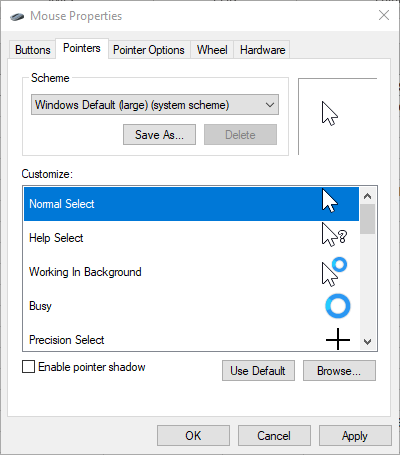Changing the Mouse Pointer
Most of us don't think too much about the mouse pointer, but Windows uses individual cursor files to specify the various pointers it uses. (Depending on which version of Windows you are using, there are 15 - 17 individual pointers that can be used, each reflecting a different condition such as "busy," "text select," resizing, or even "unavailable.") In addition, Windows "packages" a collection of cursor files into what is called a "scheme."
Windows allows you to specify which pointer scheme should be used and, further, to modify the individual cursor files, if desired. Just follow these steps:
- Display the Control Panel.
- Click the Hardware and Sound link.
- Click the Mouse link (under the Devices and Printers heading). Windows displays the Mouse Properties dialog box.
- Make sure the Pointers tab is displayed. (See Figure 1.)

Figure 1. The Pointers tab of the Mouse Properties dialog box.
- Use the Scheme drop-down list to specify how you generally want the mouse pointer to look. (Pick a few different ones so you can get an idea of what pointers are in each scheme.)
- If desired, double-click on any of the individual cursors in the Customize list. Windows displays the Browse dialog box so you can locate and select a cursor file defining how that particular mouse pointer should look.
- When you are done making changes, click OK. Your changes take effect immediately.
Author Bio
Allen Wyatt
With more than 50 non-fiction books and numerous magazine articles to his credit, Allen Wyatt is an internationally recognized author. He is president of Sharon Parq Associates, a computer and publishing services company. Learn more about Allen...
Sorting Tabular Tables
Some people like to format simple tables using tabs instead of using Word's table editor. When it comes time to sort such ...
Discover More
Ignoring N/A Values in a Sum
You can use some of Excel's worksheet functions across a range or worksheets, but not all of them. One that has problems ...
Discover More
Changing the Comment Color
Normally Excel displays comments in a color reminiscent of sticky notes you keep around your office. If you want them to ...
Discover More
Disabling the Windows 10 Blurred Sign-on Screen
The later updates to Windows 10 introduced blurred background images on the sign-in screen. If you prefer to have the ...
Discover More
Restoring Send To Desktop (Create Shortcut)
Sometimes the "Send to | Desktop (create shortcut)" option disappears, or perhaps it was never there in the first place. ...
Discover More
Using the System Information Tool
Need to lift the hood and look into the inner workings of Windows? One place you can do this easily is through the System ...
Discover More

![]()
![]()
![]() This tip (12646) applies to Windows 7, 8, and 10.
This tip (12646) applies to Windows 7, 8, and 10.
Comments